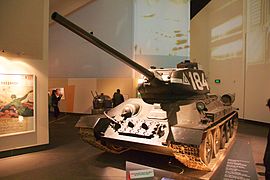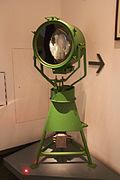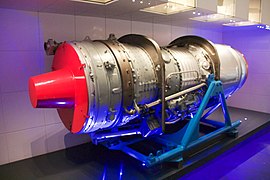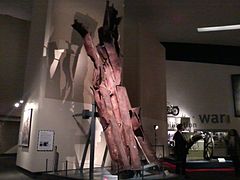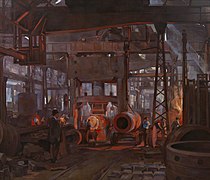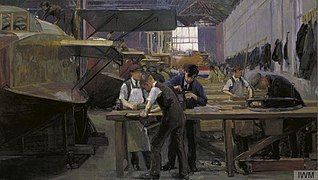Imperial War Museum North
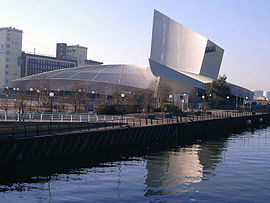 | |
| Established | 5 July 2002 |
|---|---|
| Location | The Quays Trafford Wharf Road Trafford Park Greater Manchester England |
| Coordinates | 53°28′11″N 2°17′56″W / 53.4697°N 2.2989°W |
| Type | War museum |
| Visitors | 244,564 (2019)[1] |
| Public transit access | Imperial War Museum |
| Website | iwm.org.uk/visits/iwm-north |
| Imperial War Museums | |
Imperial War Museum North (sometimes referred to as IWM North) is a museum in the Metropolitan Borough of Trafford in Greater Manchester, England. One of five branches of the Imperial War Museum, it explores the impact of modern conflicts on people and society. It is the first branch of the Imperial War Museum to be located in the north of England. The museum occupies a site overlooking the Manchester Ship Canal on Trafford Wharf Road,[2] Trafford Park, an area which during World War II was a key industrial centre and consequently heavily bombed during the Manchester Blitz in 1940.[3] The area is now home to the Lowry cultural centre and the MediaCityUK development, which stand opposite the museum at Salford Quays.
The museum building was designed by architect Daniel Libeskind and opened in July 2002, receiving 470,000 visitors in its first year of opening. It was recognised with awards or prize nominations for its architecture and is a prime example of Deconstructivist architecture. The museum features a permanent exhibition of chronological and thematic displays, supported by hourly audiovisual presentations which are projected throughout the gallery space. The museum also hosts a programme of temporary exhibitions in a separate gallery. Since opening, the museum has operated a successful volunteer programme, which since January 2007 has been run in partnership with Manchester Museum. As part of a national museum, Imperial War Museum North is financed by the Department for Culture, Media and Sport and by self-generated income. Admission is free.
Planning and construction
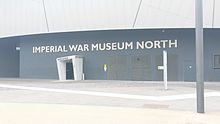
During the 1990s, the Imperial War Museum sought to open a branch in the north of England. Seventy-one sites were offered for consideration by 36 local councils.[4] One such council was that of Hartlepool, in County Durham, for whom a new museum building was designed by architect Sir Norman Foster for a site on Hartlepool's dockside.[5] In 1992 the Teesside Development Corporation offered the museum, on behalf of Hartlepool council, a total of £14.4 million towards construction and running costs.[6] However, the National Audit Office later reported that the corporation's offer breached government rules and negotiations were abandoned.[6][7]

In January 1999 the then Culture Secretary Chris Smith launched a project to construct the new museum in Trafford, Greater Manchester.[4][8] The Trafford Park area has strong associations with the Second World War on the British home front; factories in the area produced Avro Lancaster heavy bombers, and Rolls-Royce Merlin aero engines used by a number of Royal Air Force combat aircraft.[9] By 1945 the area employed 75,000 people.[10] The area was consequently heavily bombed, particularly during the Manchester Blitz, when 684 people were killed in raids over two nights in December 1940.[11] By the time of Chris Smith's announcement, the museum had already received outline planning permission (in October 1997), with full approval in April 1999.[12]
Architecture
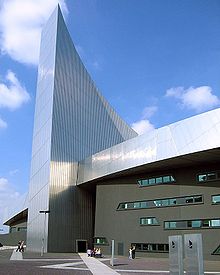
An architectural competition for the new museum was held in 1997, with the winning design being that of Berlin-based architect Daniel Libeskind. Born in Łódź, Poland, in 1946, Libeskind's family had suffered during World War II and dozens of his relatives were murdered in The Holocaust. It was his first building in the United Kingdom.[2] At the museum's opening, Libeskind said that he sought to "create a building ... which emotionally moved the soul of the visitor toward a sometimes unexpected realization"'.[13] Libeskind envisaged a 'constellation composed of three interlocking shards' [14] with each shard being a remnant of an imagined globe shattered by conflict. These shards in turn represented air, earth and water, and each formed a functionally distinct part of the museum. The 55 m high air shard, provides the museum's entranceway and a viewing balcony (now closed to the public) above the Manchester Ship Canal with views of the Manchester skyline. The construction of the tower leaves viewers exposed to the elements and one reviewer considered that it reflected "the aerial perspective of modern warfare and the precariousness of the life below".[4] The earth shard houses the museum's exhibition spaces, while the water shard accommodates a cafe with views of the canal.
Originally budgeted at £40 million, the museum was eventually completed for £28.5 million after anticipated National Lottery funding was not forthcoming. The museum was funded by local, national and European development agencies. The European Union's European Regional Development Fund contributed £8.9 million, English Partnerships and the Northwest Regional Development Agency £2.7 million, and £2.8 million was provided by Trafford Metropolitan Borough Council. The Peel Group, a local transport and property company, contributed £12.5 million;[12] this was reportedly the largest single sum ever given to a UK cultural project by a private enterprise.[15] The reduction in budget forced a number of changes; the substitution of metal for concrete in the construction of the shards, the removal of a planned auditorium, and a change of exhibition content. The site's external landscaping also had to be reduced; in 2009, following an architectural design competition managed by RIBA Competitions, Berlin-based company Topotek 1 were appointed to complete this landscaping.[16] Despite these economies, the fundamental "shattered globe" concept remained intact.[17] A final £3 million was raised by a fundraising campaign led by BBC News war correspondent Kate Adie.[18] Construction of the museum, by structural engineers Arup and main contractor Sir Robert McAlpine,[12] began on 5 January 2000[12] and the building was topped out in late September that year.[17] Exhibition fitting started in November 2001,[13] and the museum opened to the public on 5 July 2002, shortly before the 2002 Commonwealth Games which were hosted in Manchester that year.
Exhibitions
Permanent exhibitions are housed in the museum's first-floor main gallery space within the earth shard. These consist of a chronological display which runs around the gallery's 200-metre (660 ft) perimeter and six thematic displays in "silos" within the space. As part of the earth shard, the 3,500 m2 floor of the gallery is curved, gradually dropping away like the curvature of the Earth from a nominal "North Pole" near the gallery's entrance.[19] Within this hall, described as cavernous and dramatic,[18][20] a number of large artefacts are displayed; they include a Russian T-34 tank, a United States Marine Corps AV-8A Harrier jet and a 13-pounder field gun which fired the British Army's first shot of World War I.[21] Around the gallery, a number of vertical mechanical conveyors called "timestacks" display selections of smaller artefacts, some of which can be handled by visitors.[18][22][23] Libeskind's subsequent work on the masterplan for renewal the World Trade Centre site is echoed in the exhibit of a 7 m (23 ft) section of twisted steel from that building.[24]
- Objects in the IWM north collection
-
Berlin Wall searchlight
-
Mk XVII contact sea mine
-
QF 13-pounder field gun
-
Rolls Royce Olympus 101 jet engine
-
WE 177 British nuclear bomb
-
Wreckage from the September 11 attacks on New York's World Trade Center
The museum also displays artworks by official war artists who were commissioned to create a visual record of Britain during the world wars, among them Building Flying-Boats by Flora Lion; The 'L' Press. Forging the Jacket of an 18-inch Gun by Anna Airy; and Going to Work by L. S. Lowry (1943).[25]
- War artists displayed at IWM north
-
The 'L' Press. Forging the Jacket of an 18-inch Gun by Anna Airy (1918)
-
Building Flying-Boats by Flora Lion (1919)
-
Going to Work by L. S. Lowry (1943)
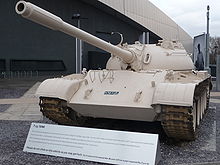
In addition to the physical exhibits, the walls of the gallery space are used as screens for the projection of hourly audiovisual presentations called the Big Picture, which explore themes related to modern conflict. These presentations use up to 1,500 images from the Imperial War Museum's photograph archive and were originally projected from 60 synchronised slide projectors mounted throughout the space.[22] In 2011 digital projectors were installed, allowing a greater degree of flexibility.[26] The images are complemented by personal accounts from the museum's oral history sound archive. The Big Picture was devised after the reduction in the museum's budget forced the scrapping of the previous exhibition plan by designers DEGW and Amalgam.[27] With some seeing one of the museum's shortcomings as a lack of artefacts, the projections and the building itself are now the main attractions.[28]
Also within the earth shard, a separate gallery accommodates a programme of temporary exhibitions. These have included the Witness series of art exhibitions from the museum's collection, examining First and Second World War art, and the work of female war artists.[29][30][31]
The WaterWay, a passageway linking the earth and water shards, is used for smaller art or photographic exhibitions, such as Ghislaine Howard's photojournalism-inspired painting series 365.[32]
Outside the museum building, an ex-Iraqi Ground Forces T-55 tank was put on display at the main entrance in August 2008. This vehicle was captured by the Royal Engineers during the opening stages of the Iraq War in 2003.[33] The spot had previously been occupied by an Iraqi ZSU-23-4 Shilka anti-aircraft gun. Captured by the Royal Artillery after the 1991 Gulf War, it was moved from Imperial War Museum Duxford and displayed to mark the museum's fifth anniversary in July 2007.[34]
Reception
The museum enjoyed a successful first year, with an initial target of 300,000 visitors surpassed after six months,[35] with over 100,000 visitors in the first six weeks;[36] by the museum's first anniversary on 5 July 2003 some 470,000 visitors had been received.[37] The museum won the Building Award in the 2003 British Construction Industry Awards,[38] and was shortlisted for the 2004 Stirling Prize.[39] The museum received a largely positive critical reception, with reviewers remarking on the metaphorical power of the building, the complementary effects of the museum's main exhibition with its internal architecture, and the economy with which the museum was built.[4][21][40] In August 2005 Imperial War Museum North received its millionth visitor.[41] The museum was, however, criticised in 2008 by The Guardian for poor energy efficiency, as part of a report into the carbon dioxide emissions of UK public buildings.[42]
Volunteer programme

Supporting Imperial War Museum North's educational goals, the museum has operated a volunteer programme since opening in 2002. The programme seeks to engage local people at risk of social exclusion. Originally based on a National Vocational Qualification, the programme was revised and relaunched in 2004, and consisted of a basic cultural heritage course, providing opportunities to develop academic skills and improve confidence, and to support individuals seeking to return to employment.[43] In return volunteers work in the museum's public spaces as part of the front of house teams. In January 2007 the museum launched the in Touch volunteer programme, in partnership with Manchester Museum and supported by £425,000 from the National Lottery Heritage Fund.[44] The programme was recognised by the Department of Culture, Media and Sport as a case study of its kind, in the department's Third Sector Strategy.[45]
References
- ^ "ALVA - Association of Leading Visitor Attractions". alva.org.uk. Retrieved 9 November 2020.
- ^ a b Hartwell, Clare (2002). Manchester (Pevsner Architectural Guide). New Haven and London: Yale University Press. p. 342. ISBN 978-0-300-09666-8.
- ^ Gray, Edward (2000). Salford Quays. The Story of Manchester Docks. Manchester: Memories Publications. p. 99. ISBN 1-899181-88-1.
- ^ a b c d Glancey, Jonathan (22 April 2002) The Guardian War and peace and quiet. Retrieved 14 April 2010
- ^ Glancey, Jonathan (27 July 1994) The Independent Architecture: Renaissance in the North. Retrieved 7 October 2009.
- ^ a b National Audit Office (27 February 2002) The Operation and wind up of Teesside Development Corporation Archived 10 October 2009 at the Wayback Machine (London: The Stationery Office) p.26. Retrieved 6 October 2009.
- ^ Hartlepool Mail (27 February 2002) (findarticles.com) TDC cost taxpayers £34m. Retrieved 6 October 2009.
- ^ PR Newswire (Press Release) (25 January 1999) Smith hails 'wonderful' War Museum project Archived 28 February 2012 at the Wayback Machine. Retrieved 22 October 2009.
- ^ Nicholls, Robert (1996), Trafford Park: The First Hundred Years, Chichester: Phillimore & Co Ltd, ISBN 1-86077-013-4 pp. 103–104
- ^ Nevell, Michael (1997), The Archaeology of Trafford, Manchester: Trafford Metropolitan Borough with University of Manchester Archaeological Unit, ISBN 1-870695-25-9 pp. 130–133
- ^ Imperial War Museum North (2009) Manchester Blitz. Retrieved 22 October 2009.
- ^ a b c d Williams, Austin (19 October 2000) Architects' Journal Conflict Resolution. Retrieved 6 October 2009.
- ^ a b Forrester, Jim (2004) Manchester Region History Review Vol. 17 No. 1 War & Conflict: New Perspectives in the North Archived 18 July 2011 at the Wayback Machine. (Manchester: Manchester Metropolitan University). Retrieved 14 March 2012.
- ^ Libeskind, Daniel; Studio Daniel Libeskind Imperial War Museum North. Retrieved 7 October 2009.
- ^ Vallely, Paul (17 July 2002) The Independent It's grand up North. Retrieved 15 October 2009.
- ^ George, Sophie (12 June 2009) Architects' Journal First Look: Topotek 1 adds to Libeskind's Imperial War Museum North. Retrieved 9 October 2009.
- ^ a b Herbert, Ian (9 October 2000)The Independent The museum that was bowed – but not broken – by the lottery. Retrieved 7 October 2009.
- ^ a b c Herbert, Ian (3 July 2002) The Independent Libeskind's war museum triumphs over cost-cutters[dead link]. Retrieved 9 October 2009.
- ^ Architects' Journal (14 August 2003) Case study: A striking, sculptural landmark building on the waterfront.... Retrieved 9 October 2009.
- ^ Hughes, Matthew (Winter 2002) Institute of Historical Research: History in Focus The Imperial War Museum (North): The Triumph of Style over Substance?. Retrieved 9 October 2009.
- ^ a b Worsley, Giles (29 June 2002) The Daily Telegraph A globe ripped to pieces. Retrieved 9 October 2009.
- ^ a b Martin, David 'Full metal jacket: Imperial War Museum North' Museum Practice No. 21, December 2002, pp. 24–29
- ^ Imperial War Museum North (2009) IWM North Floorplan[permanent dead link]. Retrieved 14 March 2012.
- ^ Schofield, Jonathan (2015). My Guide to Manchester. Manchester: Manchester Books. p. 139. ISBN 978-0-9927590-1-8.
- ^ "Lowry's 'Going to Work' returns to Manchester". Imperial War Museums. 2021. Archived from the original on 1 May 2021. Retrieved 13 January 2023.
- ^ Culture24 reporter (21 July 2011). "Imperial War Museum North uses Big Picture Show to tell personal story of Afghanistan". culture24.org.uk. Retrieved 28 January 2012.
{{cite web}}: CS1 maint: numeric names: authors list (link) - ^ Architects' Journal (28 January 1999) Libeskind's war museum to go ahead – but at a cost.. Retrieved 12 October 2009.
- ^ Glinert, Ed (2009). The Manchester Compendium. London: Penguin Books. p. 193. ISBN 978-0-141-02930-6.
- ^ Moss, Richard (14 February 2006) Culture24.org.uk Witness: Art Of The First World War At IWM North Archived 16 July 2011 at the Wayback Machine. Retrieved 12 October 2009.
- ^ Kershaw, Alice (2 February 2007) Culture24.org.uk Witness 2 – The Art Of WWII At Imperial War Museum North. Retrieved 12 October 2009.
- ^ Culture24.org.uk (11 February 2009) Witness: Women War Artists At IWM North. Retrieved 12 October 2009.
- ^ Bambury, Adam (27 February 2009) Culture24.org.uk Interview: Ghislaine Howard discusses 365 at Imperial War Museum North. Retrieved 15 October 2009.
- ^ Fleming, Grace (26 August 2008) Manchester Evening News Iraq tank rolls into museum. Retrieved 13 October 2009.
- ^ Rusby, Jake (5 July 2007) Manchester Evening News Museum's birthday 'invasion'. Retrieved 25 November 2009.
- ^ Scheerhout, John (9 January 2003) Manchester Evening News 300,000 answer museum call-up. Retrieved 6 October 2009.
- ^ Ward, David (13 August 2003) The Guardian Museum opens brightly on back of games success. Retrieved 6 October 2009.
- ^ Imperial War Museum Account 2003–2004 (20 May 2005) official-documents.gov.uk (London: The Stationery Office). Retrieved 6 October 2009.
- ^ British Construction Industry Awards Winners 2003. Retrieved 9 October 2009.
- ^ Royal Institute of British Architects Stirling Prize 2004 Archived 3 June 2008 at the Wayback Machine. Retrieved 9 October 2009.
- ^ Newsnight Review (transcript) (12 July 2002) BBC News. Retrieved 9 October 2009.
- ^ Moss, Richard (18 August 2005) Culture24.org.uk IWM North Welcomes Its Millionth Visitor. Retrieved 13 October 2009.
- ^ Booth, Robert (2 October 2008) The Guardian Halls of shame: biggest CO2 offenders unveiled. Retrieved 10 October 2009.
- ^ Northwest Development Agency (25 May 2005) Imperial War Museum North awarded for Volunteers Programme Archived 10 April 2009 at the Wayback Machine. Retrieved 14 October 2009.
- ^ Manchester Museum/Imperial War Museum North (July 2009) In Touch volunteer programme: Volunteering and training at the Manchester Museum and Imperial War Museum North p.4. Retrieved 14 March 2012.
- ^ Department for Culture, Media and Sport (April 2009) DCMS: Third Sector Strategy p.27. Retrieved 14 October 2009.
External links
- Official Website Archived 2 April 2004 at the Wayback Machine


